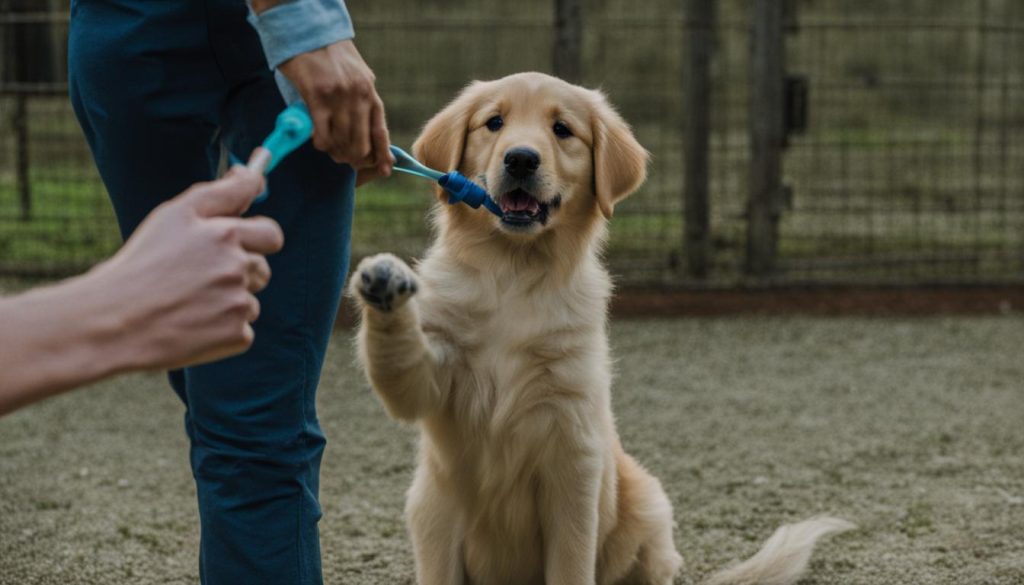Teaching your dog to sit on their hind legs is not only a fun trick but also a great way to engage their minds and strengthen their core muscles. Whether your dog is a natural or needs a little training, follow these steps to teach them how to sit pretty.
Key Takeaways:
- Teaching your dog to sit on hind legs improves their balance and strengthens their core muscles.
- Start by getting your dog into a sitting position and slowly raise a treat above their head.
- Use positive reinforcement techniques and gradually increase the duration of the behavior.
- Practice regularly and incorporate variations to keep the trick challenging and impressive.
- Ensure your dog’s safety, monitor them during training sessions, and seek professional help if needed.
Why Teach Your Dog To Sit On Hind Legs?
Teaching your dog to sit on hind legs can have several benefits. It improves their balance and strengthens their core muscles. Additionally, it can be a great way to mentally stimulate your dog and provide them with a challenge. By incorporating this trick into your dog’s training routine, you can enhance their overall obedience and behavior.
The Benefits of Teaching Your Dog To Sit On Hind Legs
When you teach your dog to sit on hind legs, you are not just teaching them a fun trick. You are also helping them develop important physical and mental skills. Sitting on hind legs improves their balance and coordination, as they learn to distribute their weight evenly. It also strengthens their core muscles, which can lead to better posture and overall physical health.
Moreover, training your dog to sit on hind legs provides mental stimulation. It challenges their cognitive abilities and engages their problem-solving skills. This can be particularly beneficial for high-energy or intelligent breeds that require mental exercise to prevent boredom and destructive behavior.
Incorporating this trick into your dog’s training routine can also enhance their overall obedience and behavior. It teaches them impulse control and reinforces their understanding of commands. By consistently practicing this trick, you are reinforcing the connection between your dog’s action and your reward, strengthening their obedience training.

Starting the Training Process
To teach your dog to sit on hind legs, you can follow a few simple steps. First, start by getting your dog into a sitting position. Hold a treat above their head, slowly raising it towards their back. As your dog follows the treat with their eyes and nose, their front paws may naturally lift off the ground. When this happens, give them the command “sit pretty” and reward them with the treat. Repeat this process several times to reinforce the behavior.
| Step | Description |
|---|---|
| 1 | Get your dog into a sitting position. |
| 2 | Hold a treat above their head. |
| 3 | Raise the treat towards their back. |
| 4 | As their front paws lift off the ground, give the command “sit pretty” and reward them with the treat. |
| 5 | Repeat this process to reinforce the behavior. |
I recommend that you be patient and consistent with your training. Start with short training sessions and gradually increase the duration as your dog becomes more comfortable. By using positive reinforcement and rewards, you can motivate your dog to learn and perform this trick.
Building Strength and Balance
As your dog starts to become more comfortable with sitting on hind legs, you can gradually increase the duration of the behavior. Start by rewarding them for just a few seconds and gradually work your way up to longer periods. This will help build their strength and balance. If your dog is struggling to maintain the position, you can provide support by holding their front paws gently.
Incorporating sit pretty into their training routine will not only strengthen their core muscles but also improve their overall balance. By gradually increasing the duration of the behavior, your dog will develop the necessary strength to hold the position for extended periods of time. Try to always provide positive reinforcement, praising and rewarding your dog for their efforts.
| Tip | Explanation |
|---|---|
| Gradual Progression | Start with short intervals and gradually increase the duration of the behavior to build strength and balance. |
| Supportive Assistance | If your dog is struggling to maintain the position, you can provide support by gently holding their front paws. |
| Positive Reinforcement | Praise and reward your dog for their efforts to encourage them to continue practicing the behavior. |
By incorporating these training techniques, you are helping your dog develop the necessary physical skills to perform the sit pretty trick. You should remember that each dog is unique and may progress at their own pace. Be patient, consistent, and always prioritize their safety during training sessions.
Practice Makes Perfect
Consistency is key when training your dog to sit on hind legs. Set aside regular training sessions to practice this trick. Use positive reinforcement techniques, such as treats or praise, to motivate your dog. Try to keep the training sessions short and engaging, gradually increasing the difficulty level as your dog progresses.
During the training sessions, be patient and understanding. Some dogs may pick up the trick quickly, while others may require more time and practice. The key is to remain positive and encouraging throughout the process. Celebrate even the small successes to keep your dog motivated and eager to learn.
In addition to regular training sessions, it’s also helpful to incorporate the “sit pretty” command into everyday situations. For example, you can ask your dog to sit on hind legs before giving them their food or before crossing the street during a walk. This reinforces the behavior and helps your dog understand that this trick is not just limited to training sessions.
To put it simply, every dog is unique, and the training process may vary. If you’re facing challenges or if your dog is not progressing as quickly as you’d like, don’t hesitate to seek professional help. A qualified dog trainer can provide expert guidance and tailor the training to your dog’s specific needs.
Troubleshooting and Tips

When teaching your dog to sit on hind legs, it’s normal to encounter some challenges along the way. Here are some troubleshooting tips and helpful advice to make the training process smoother and more successful:
- Start with a non-slip surface: If your dog is having trouble maintaining balance, practicing on a non-slip surface can help provide better traction and stability.
- Use a support: If your dog is struggling to stay in the “sit pretty” position, you can provide support by gently holding their front paws. This will help them build confidence and maintain balance.
- Be patient and consistent: Like any new behavior, it takes time for your dog to learn and master sitting on hind legs. Stay patient, and consistently practice the trick during short training sessions to reinforce the behavior.
- Provide encouragement: Positive reinforcement is key to successful training. Offer plenty of praise, treats, and affection to motivate your dog and make the training experience enjoyable.
To put it simply, every dog is unique, and tailor your training approach to suit your dog’s individual needs. If you’re facing persistent difficulties or need additional guidance, consider seeking professional help from a certified dog trainer. They can offer specialized training techniques and personalized advice to address specific challenges.
Adding Variations to the Trick
Once your dog has mastered sitting on hind legs, you can explore different variations of the trick to further challenge them and showcase their skills. These variations will not only provide mental stimulation but also strengthen their core muscles and improve their balance. Here are a few ideas to add some flair to the trick:
1. Paws Higher:
Encourage your dog to raise their paws higher while maintaining the sitting position. Start by using a higher treat or toy to lure them upwards. Gradually increase the height until they can comfortably hold their paws at an impressive height.
2. One Paw Extended:
Teach your dog to extend one paw while balancing on the other. This variation adds an extra level of difficulty and coordination. Begin by guiding their extended paw with a treat and reward them when they successfully maintain the position.
3. Spin:
Expand the trick by teaching your dog to spin in a circle while sitting on their hind legs. Start with small, controlled movements in one direction and gradually increase the speed and distance of the spin. Reward them for completing the spin and maintaining their balance throughout.
Try to be patient and consistent when introducing these variations. Break down each variation into smaller steps and reward your dog for their effort and progress. With practice and positive reinforcement, your dog will continue to impress and delight with their newfound skills.

Incorporating Sit Pretty into Everyday Life
Now that your dog has learned how to sit on their hind legs, it’s time to incorporate this impressive trick into their everyday life. By doing so, you can reinforce their training, provide mental stimulation, and make the behavior a natural part of their routine.
One way to incorporate sit pretty into everyday life is by using it as a way for your dog to ask for treats or attention. Teach them to perform the trick whenever they want a reward, and be sure to give them plenty of praise and treats when they do it correctly. This will reinforce the behavior and encourage them to continue doing it.
Additionally, encourage your family and friends to participate in the training process. Ask them to give your dog rewards or attention when they perform sit pretty. This will help reinforce the behavior and show your dog that it can be an enjoyable experience.
Try to keep the training sessions short and engaging. Practice sit pretty in different environments and with various distractions to help your dog generalize the behavior. With consistency and positive reinforcement, your dog will soon be incorporating sit pretty into their everyday life with ease.

Benefits of Incorporating Sit Pretty into Everyday Life
Incorporating sit pretty into your dog’s daily routine has several benefits. It helps maintain their mental and physical well-being by providing mental stimulation and exercise. The trick also strengthens their core muscles, improves balance, and enhances their overall obedience and behavior.
| Benefits of Incorporating Sit Pretty into Everyday Life | Explanation |
|---|---|
| Physical exercise | Sitting on hind legs engages core muscles and promotes balance. |
| Mental stimulation | Learning and performing the trick challenges your dog’s cognitive abilities. |
| Bonding opportunity | Training and practicing sit pretty together strengthens the bond between you and your dog. |
| Impressive trick | Having your dog perform sit pretty can impress family, friends, and even strangers. |
By incorporating sit pretty into everyday life, you are not only showcasing your dog’s skills but also providing them with mental and physical enrichment. Enjoy the process of training and bonding with your furry friend, and watch them thrive as they master this impressive trick.
Training Classes and Professional Help
If you’re having difficulty teaching your dog to sit on hind legs or if you want to take their training to the next level, it’s worth considering enrolling them in a dog training class or seeking professional help. Trainers have the knowledge and experience to provide additional guidance and expertise to help you and your dog succeed.
In a dog training class, your dog will have the opportunity to socialize with other dogs and learn in a structured environment. Trainers can teach you effective training techniques and help you address any specific challenges you may be facing. They can also provide personalized advice tailored to your dog’s individual needs and learning style.
Professional trainers can also be a valuable resource if your dog has behavioral issues that need to be addressed. They can help identify the underlying causes of problem behaviors and develop a personalized training plan to address them. This can improve your dog’s obedience and overall behavior, leading to a happier and more well-behaved pet.
To put it simply, training your dog is a journey, and be patient and consistent. With the help of a professional, you can ensure that you’re using the most effective training techniques and giving your dog the support they need to succeed.

Benefits of Training Classes and Professional Help
| Benefits | Dog Training Classes | Professional Help |
|---|---|---|
| Structured learning environment | ✓ | ✓ |
| Socialization opportunities | ✓ | – |
| Personalized guidance | – | ✓ |
| Addressing specific challenges | ✓ | ✓ |
| Behavioral issue management | – | ✓ |
| Improved obedience and behavior | ✓ | ✓ |
Safety Precautions
When teaching your dog to sit on hind legs, prioritize their safety. By taking a few precautions, you can ensure a positive and secure training experience for your furry friend.
Avoid Strain on the Back and Legs
When teaching your dog to sit on hind legs, be mindful of the strain you are putting on their back and legs. Start with short training sessions and gradually increase the duration as your dog builds strength and balance. If you notice any signs of discomfort or fatigue, give them a break and consult with a professional if needed.
Choose the Right Surface
Make sure to practice on a non-slip surface to prevent your dog from slipping or sliding during the training process. A carpeted area or a rubber mat can provide better traction and stability for your dog as they learn to sit on their hind legs. This will reduce the risk of injuries and help them feel more secure during the training sessions.
Monitor Your Dog’s Progress
Throughout the training sessions, closely monitor your dog’s behavior and physical condition. If you notice any signs of discomfort, such as limping or excessive panting, stop the training and consult with a veterinarian. Don’t forget that every dog is different, and what works for one may not work for another. Adjust your training approach as needed to ensure your dog’s safety and well-being.
| Safety Precautions | Summary |
|---|---|
| Avoid Strain on the Back and Legs | Start with short training sessions and gradually increase duration. Watch for signs of discomfort or fatigue. |
| Choose the Right Surface | Practice on a non-slip surface, such as carpet or a rubber mat, to prevent slipping and injuries. |
| Monitor Your Dog’s Progress | Pay close attention to your dog’s behavior and physical condition during training. Stop if any signs of discomfort or distress emerge. |
By following these safety precautions, you can ensure a secure and enjoyable training experience for both you and your dog. Don’t forget that patience and consistency are key when teaching your dog new tricks, and always prioritize their safety and well-being throughout the process.

Final Thoughts
To conclude, teaching your dog to sit on hind legs can be a fun and rewarding endeavor. By following the steps outlined in this article, you can successfully train your dog to perform this impressive trick. Try to be patient and consistent in your training sessions, using positive reinforcement to motivate your furry friend.
Not only does teaching your dog to sit on hind legs impress others, but it also has several benefits for your pet. It improves their balance, strengthens their core muscles, and provides mental stimulation. By incorporating this trick into your dog’s training routine, you can enhance their overall obedience and behavior.
As you progress with training, remember to prioritize your dog’s safety and enjoyment. Avoid putting too much strain on their back or legs, and monitor their movements closely during training sessions. If you encounter any challenges or want to take their training to the next level, consider enrolling them in a dog training class or seeking professional help.
Enjoy the process of bonding with your furry friend as you teach them new tricks and watch them grow. With time and effort, your dog will master sitting on hind legs, adding a delightful and impressive behavior to their repertoire.
FAQ
How long does it take to teach a dog to sit on hind legs?
The time it takes to teach a dog to sit on hind legs can vary depending on the dog’s individual temperament and previous training experience. With consistent practice and positive reinforcement, most dogs can learn this trick within a few weeks.
Can all dogs learn to sit on hind legs?
While most dogs can learn to sit on hind legs with proper training and practice, some breeds may find it more challenging due to their size or physical limitations. I recommend that you consider your dog’s comfort and safety when teaching this trick.
How often should I practice the sit on hind legs trick?
Regular training sessions are essential for teaching your dog to sit on hind legs. Aim for short, frequent practice sessions of about 5-10 minutes each. This will help keep your dog engaged and prevent them from becoming bored or fatigued.
What if my dog is struggling to balance or stay in the “sit pretty” position?
If your dog is having difficulty maintaining balance or staying in the “sit pretty” position, you can try using a wall or other support to provide stability. Be patient and provide plenty of encouragement during the training process. You can also consult a professional trainer for additional guidance.
Can I teach my dog other variations of the sit on hind legs trick?
Yes, once your dog has mastered the basic sit on hind legs position, you can add variations to the trick. For example, you can teach them to raise their paws higher or extend one paw while balancing on the other. These variations can make the trick more impressive and challenging for your dog.
How can I use the sit on hind legs trick in everyday life?
Once your dog has learned how to sit on hind legs, you can incorporate this behavior into everyday life. Use it as a way for your dog to ask for treats or attention, or as part of a performance routine. Encourage family and friends to give your dog rewards when they perform the trick to reinforce the behavior.
Should I consider enrolling my dog in a training class?
If you’re struggling to teach your dog to sit on hind legs or want to take their training to the next level, enrolling them in a dog training class can be beneficial. Trainers can provide additional guidance and expertise to help you and your dog succeed.
How can I ensure my dog’s safety during training?
When teaching your dog to sit on hind legs, prioritize their safety. Avoid putting too much strain on their back or legs and avoid practicing on slippery surfaces. Always monitor your dog during training sessions and make adjustments as needed to prevent any injuries.
Do I need any special equipment to teach my dog to sit on hind legs?
No special equipment is required to teach your dog to sit on hind legs. However, using treats or toys as rewards can be helpful in motivating your dog during the training process.






